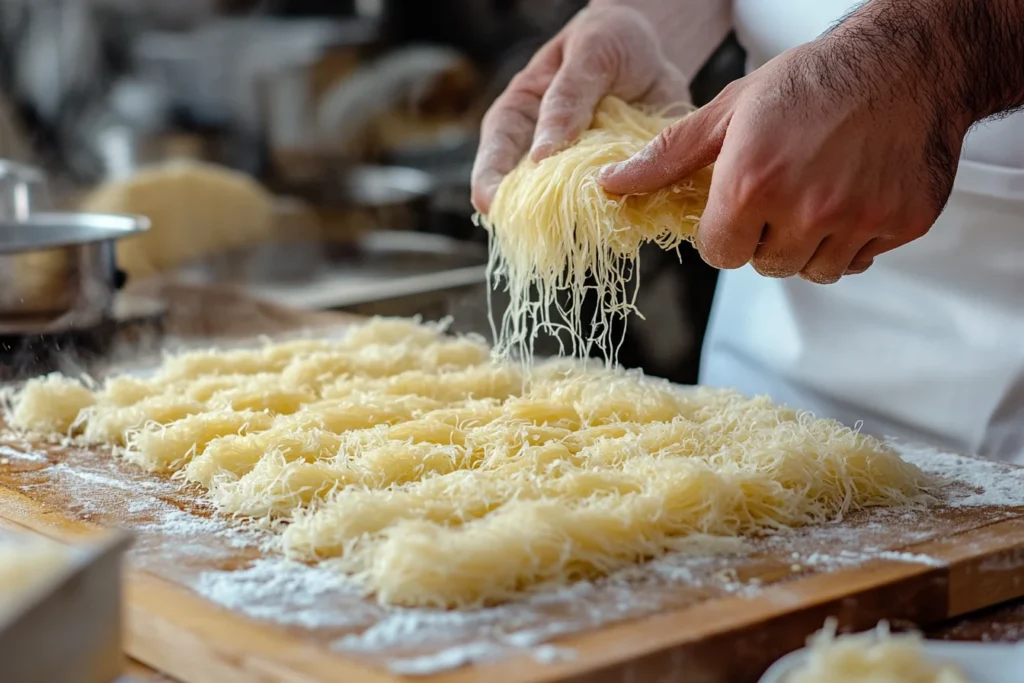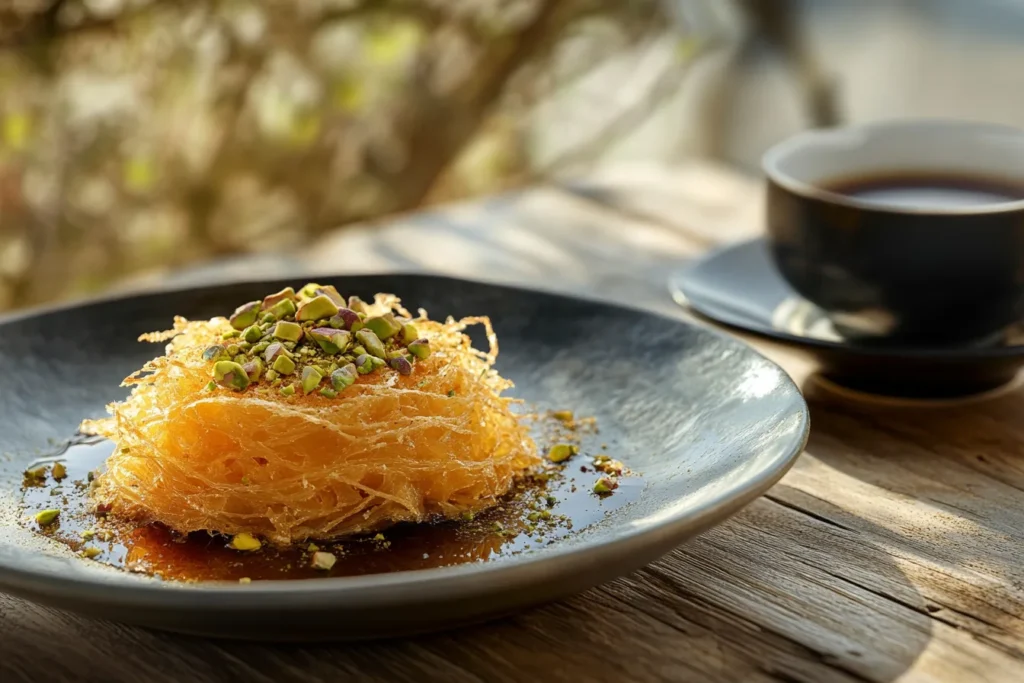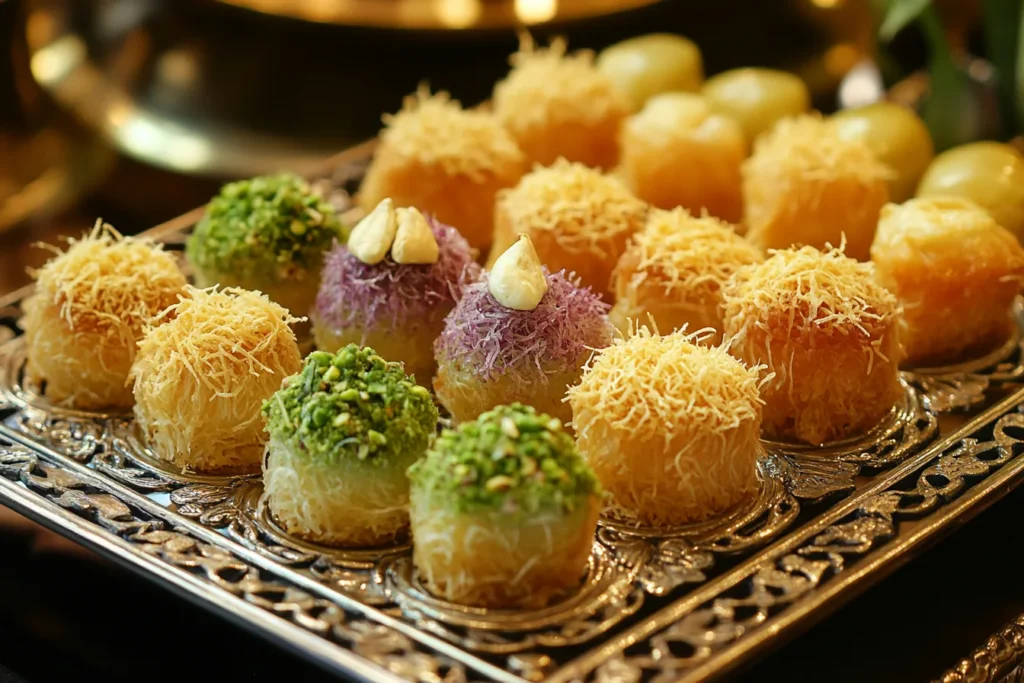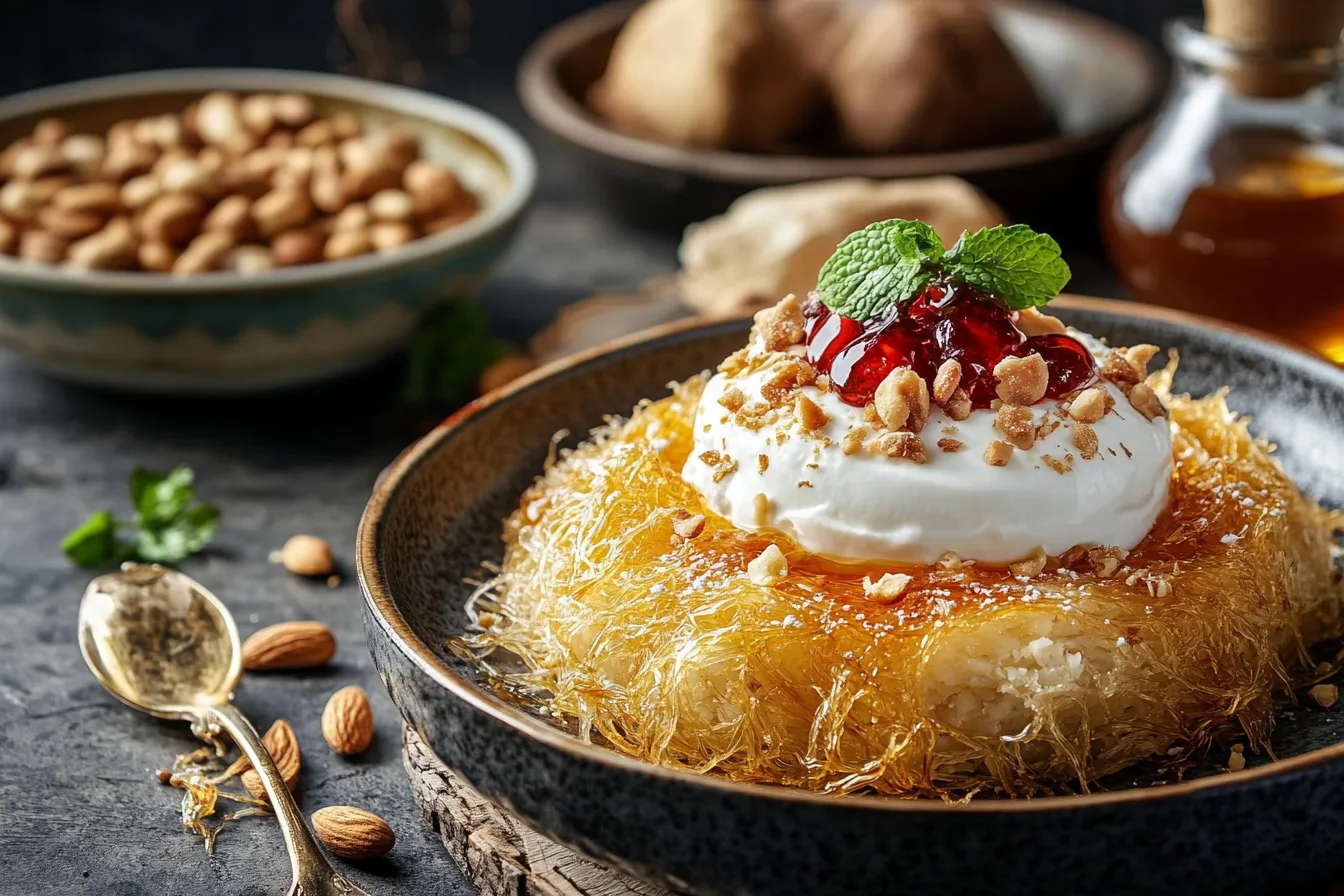Kataifi, a delicate and intricate pastry, is a cherished dessert and savory dish in many cuisines worldwide, particularly in the Mediterranean and Middle Eastern regions. Its unique shredded dough, often compared to finely shredded phyllo pastry, creates a crispy, golden texture that pairs beautifully with an array of fillings and flavors.
The versatility of kataifi allows it to transition seamlessly between sweet and savory dishes. Whether soaked in fragrant syrups or filled with savory ingredients like cheese or spiced meats, kataifi holds a special place on festive tables and in everyday indulgences alike.
What Makes Kataifi Unique?
Kataifi stands out due to its shredded pastry dough, which is made by pouring a thin batter onto a hot rotating plate, creating hair-thin strands. This texture is not only visually striking but also offers a delightful crunch when baked or fried. The dough’s versatility ensures its place in both traditional recipes and modern culinary innovations.
The Origins of Kataifi: A Historical Perspective
The history of kataifi is closely tied to the rich culinary traditions of the Eastern Mediterranean and Middle Eastern regions. Thought to have roots in the Byzantine Empire, kataifi was refined and popularized in Ottoman kitchens, where chefs experimented with various fillings and syrups. Over time, it became a beloved dish across Greece, Turkey, Lebanon, and beyond.
Ingredients Used in Kataifi Pastry
Main Ingredients: The Essence of Kataifi
The core ingredients for kataifi dough include:
- Flour: Usually all-purpose or a specialized pastry flour.
- Water: Ensures the batter’s fluidity.
- Salt: Adds subtle flavor to the dough.
For fillings and toppings, common ingredients are:
- Sweet Fillings: Nuts like pistachios, walnuts, or almonds.
- Savory Fillings: Cheese, minced meat, or vegetables.
- Syrup: A mix of sugar, water, lemon juice, and optional flavorings like rose or orange blossom water.
Variations in Ingredients Across Cultures
Different regions adapt the basic Kataifi recipe to suit their local tastes and traditions. For instance, in Greece, Kataifi often includes a honey-based syrup, which adds a rich and floral sweetness to the dish. Meanwhile, in the Middle East, variations frequently incorporate aromatic spices like cinnamon or cardamom, creating a warm and complex flavor profile. Similarly, in Turkey, Kataifi is commonly paired with clotted cream (kaymak), enhancing its creamy texture and indulgent appeal. These regional differences not only highlight the versatility of Kataifi but also showcase how it seamlessly integrates into diverse culinary traditions.
For a deeper dive into cultural flavor combinations, explore regional recipes and their adaptations.
How Is Kataifi Made?
The process of making Kataifi involves creating ultra-thin phyllo sheets and shredding them into fine strands. These strands are then used to wrap fillings or create layered pastries. For tips on perfecting your pastry-making skills, check out baking tips for phyllo dough recipes to achieve the best results.:
Preparing Kataifi: Step-by-Step Guide

- Preparing the Dough
- To make Kataifi dough, mix flour, water, and a small amount of oil or vinegar into a simple phyllo mixture.
- Shredding the Dough
- Stretch the dough into ultra-thin sheets and shred it into fine, hair-like strands. You can achieve this using specialized machines or precise manual techniques.
- Assembling the Pastry
- Layer or wrap the shredded dough around your chosen filling. For sweet recipes, use nuts like walnuts or pistachios, while savory recipes often include cheese or minced meat.
- Butter Coating
- Brush the Kataifi strands generously with melted butter to create a golden, crispy texture during baking.
- Baking
- Bake the assembled pastry at a moderate temperature (around 350°F/175°C) to achieve a crisp and golden brown finish.
- Adding Syrup (for Sweet Kataifi)
- Pour a warm syrup made with sugar, water, and flavorings like cinnamon or orange blossom over the baked pastry. Allow the syrup to soak in, infusing the Kataifi with a rich sweetness.
Kataifi’s unique shredded texture and versatile applications make it a popular choice for both festive dishes and everyday treats.
Popular Kataifi Fillings and Flavors
Popular Kataifi Fillings and Flavors
Kataifi is a versatile pastry that pairs well with both sweet and savory fillings, offering endless culinary possibilities. Here are some popular options:
Sweet Fillings
- Nuts and Spices:
- Chopped walnuts, pistachios, or almonds are classic fillings.
- Often spiced with cinnamon, cloves, or nutmeg for a warm, aromatic flavor.
- Cream:
- Custard or whipped cream makes for a soft and luscious filling.
- Popular in Middle Eastern and Mediterranean desserts.
- Fruits:
- Dried fruits like dates, figs, or raisins add natural sweetness and texture.
- Sometimes combined with nuts for a richer flavor.
- Chocolate:
- Melted chocolate or Nutella creates a decadent twist on the traditional pastry.
- Perfect for modern interpretations of Kataifi.
Savory Fillings
- Cheese:
- Soft cheeses like feta, ricotta, or mozzarella are common in savory Kataifi recipes.
- Often paired with herbs like dill, parsley, or thyme.
- Meat:
- Ground lamb, beef, or chicken seasoned with onions, garlic, and spices makes a hearty filling.
- Ideal for appetizers or main dishes.
- Seafood:
- Shrimp or crab meat wrapped in Kataifi strands and baked until golden is a gourmet option.
- Served with a tangy dipping sauce or glaze.
- Vegetables:
- Roasted or sautéed vegetables like spinach, mushrooms, or peppers can create a vegetarian delight.
- Often combined with cheese or herbs for added flavor.
Flavored Syrups for Sweet Kataifi
- Honey and Lemon:
- A simple yet classic syrup for a bright and sweet finish.
- Orange Blossom or Rose Water:
- Adds a floral, aromatic touch to desserts.
- Maple or Caramel:
- Modern variations for a unique taste.
These fillings and flavors showcase the versatility of Kataifi, making it a beloved pastry for both traditional and innovative recipes.
Kataifi in Different Cultures
Kataifi in Middle Eastern Cuisine
In Middle Eastern countries, kataifi is a staple dessert during Ramadan and special occasions. It is often paired with kanafeh, a similar pastry made with shredded dough and cheese.
Kataifi in Mediterranean and Greek Traditions
Greek kataifi desserts are typically drizzled with honey-based syrup and often paired with Greek yogurt or cream.
Kataifi’s Global Popularity and Fusion Dishes
Today, chefs worldwide experiment with kataifi, using it in fusion dishes like kataifi-wrapped prawns or reinventing classic recipes.

Pairing Kataifi with Other Foods and Drinks
Perfect Beverages to Complement Kataifi
The light and crispy texture of kataifi, whether sweet or savory, pairs beautifully with beverages that enhance its flavors. Here are some perfect pairings:
- Sweet Kataifi Pairings:
- Coffee or Espresso: The bitterness of coffee balances the sweetness of kataifi drenched in syrup.
- Tea: Herbal teas, especially mint or chamomile, complement the fragrant spices often found in kataifi fillings.
- Dessert Wines: A glass of Muscat or Port enhances the rich, nutty flavors in sweet kataifi.
- Savory Kataifi Pairings:
- White Wine: A crisp Sauvignon Blanc or Chardonnay highlights the flavors of cheese or seafood fillings.
- Sparkling Water: Its clean, effervescent taste refreshes the palate after a rich bite of savory kataifi.
Side Dishes and Garnishes for Kataifi
- Sweet Kataifi Additions:
- Fresh fruits like strawberries, figs, or pomegranate seeds for added color and freshness.
- Savory Kataifi Complements:
- A fresh green salad with lemon vinaigrette to cut through the richness.
- Roasted vegetables or a tangy yogurt dip to provide a contrast to the crispy texture.
The Nutritional Value of Kataifi
Calories and Macronutrient Breakdown
Kataifi is a calorie-dense food, primarily due to its ingredients like nuts, cheese, and sugary syrup. Here’s a general breakdown:
- Sweet Kataifi:
- Calories: 150–250 per serving, depending on syrup content.
- Macronutrients: High in carbohydrates and fats, with moderate protein levels.
- Savory Kataifi:
- Calories: 200–300 per serving, based on the filling.
- Macronutrients: Often higher in protein due to cheese or meat fillings.
Healthier Alternatives and Modifications

Tips and Tricks for Perfect Kataifi Every Time
Avoiding Common Mistakes
- Prevent Dry Dough: Keep the dough strands covered with a damp towel to avoid drying out.
- Even Baking: Ensure the oven temperature is consistent and rotate the tray halfway through baking.
- Balanced Syrup Application: Pour syrup over the pastry while it’s still hot to ensure even absorption.
Secrets for Crispiness and Flavor
- Butter is Key: Use melted butter or clarified butter (ghee) to coat the strands evenly before baking for extra crispiness.
- Enhance Fillings: Add a touch of cinnamon, nutmeg, or cardamom to elevate the flavor profile.
- Cooling Before Serving: Allow baked kataifi to cool slightly before serving so the syrup fully sets.
Frequently Asked Questions About Kataifi
What Is the Best Way to Store Kataifi?
To keep Kataifi fresh, store it in an airtight container at room temperature if it’s baked. For uncooked Kataifi pastry, tightly wrap it in plastic wrap and refrigerate for up to a week.
Can You Freeze Kataifi Pastry?
Yes, Kataifi pastry freezes well. Wrap it tightly in plastic wrap and place it in an airtight container or freezer bag. It can be stored in the freezer for up to 3 months. Thaw it in the refrigerator overnight before use.
How Long Does Kataifi Stay Fresh?
Baked Kataifi stays fresh for 3-5 days when stored in an airtight container at room temperature. For uncooked pastry, refrigeration will keep it fresh for up to a week.
Popular Fillings and Flavors
Kataifi can be customized to suit a variety of flavors:
Savory Fillings: Popular choices are feta cheese, ground meat, or even seafood.Conclusion: The Timeless Appeal of Kataifi
Sweet Fillings: Commonly include nuts like pistachios or walnuts, paired with a syrup made from honey or rose water. For ideas on incorporating natural sweetness, see healthy snack options with minimal sugar.
Kataifi is more than just a pastry; it’s a culinary masterpiece that embodies tradition, creativity, and indulgence. Its delicate shredded dough and the endless possibilities for sweet and savory fillings make it a versatile dish loved by many cultures. Whether you’re enjoying a syrup-soaked sweet kataifi or a savory version filled with cheese or meats, this dish offers a delightful sensory experience.
From its ancient roots in Mediterranean and Middle Eastern cuisine to its modern-day adaptations, kataifi continues to inspire chefs and home cooks alike. By following simple preparation techniques and experimenting with flavors, you can bring this elegant pastry to your own table, celebrating its rich heritage and exquisite taste.

